
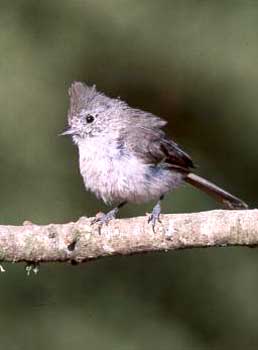
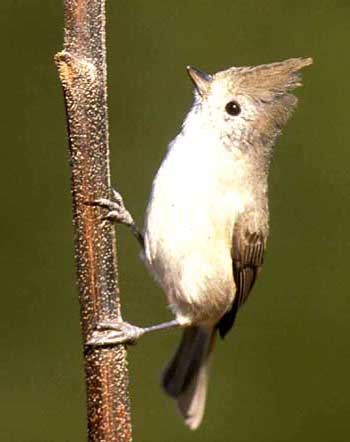 TITMICE
AT LAVA BEDS N.M., SISKIYOU CO., CALIFORNIA
TITMICE
AT LAVA BEDS N.M., SISKIYOU CO., CALIFORNIA
a photo discussion by Don Roberson
Until recently, titmice in the western United States did not engender much comment. They are essentially resident and not subject to much vagrancy. Growing up in the oak woodlands of California, I did learn at an early age that any mystery vocalization heard in that habitat would likely prove to be a titmouse, and they (along with Bewick's Wren) still are the authors of the vast majority of calls that make one pause for a moment. With the 7th edition A.O.U. Check-list, however, the "Plain Titmouse" was split into two species: Oak Titmouse Baeolophus inornatus of oak woodlands Oregon to Baja west of the Sierran/Cascades divide and Juniper Titmouse B. griseus in the Great Basin juniper woodlands east of the divide. This great shot of Oak Titmouse was taken by John Sorensen in Monterey County ("MTY" hereafter) and does show the brownish tone to the upperparts typical of MTY birds in good light. The Juniper Titmouse is essentially gray. In most places the vocalizations of the two are different and very useful for identification purposes.
A gray titmouse is common and approachable in the campground at Lava Beds National Monument, eastern Siskiyou Co., California. This is within a couple miles of the Modoc County border and I would call it within the western Modoc Plateau. During a recent overnight there my impression was that it sounded like an Oak Titmouse but looked and acted more like Juniper Titmouse. My impressions that the calls recalled Oak Titmouse is shared by others like Bruce Deuel. The habitat is entirely sparse junipers among sage; I saw no oaks in the campground. I am left confused and could use help.
I took some photos in poor light (1/30th sec.) so they are fuzzy. Below
left
is one of these mystery Lava Beds titmice in the campground; below
right
is another shot of Oak Titmouse taken by John Sorensen in MTY but
showing a bird that looks a lot grayer than the top photo, but still with
a slight brownish wash to the upperparts (all photos © 2000 D. Roberson
and J. Sorensen, respectively, as identified herein; all rights reserved).


Vocalizations aside, the Nat'l Geographic field guide says that
the Juniper's bill is "usually larger" and their painting shows a bit thicker
bill. Compare bill size of this Oak Titmouse from Monterey Co. (left) with
the Lava Beds titmouse (right).
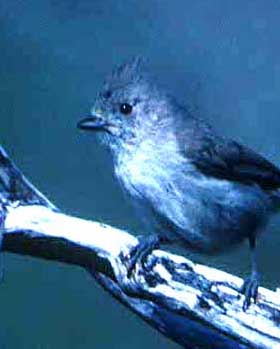
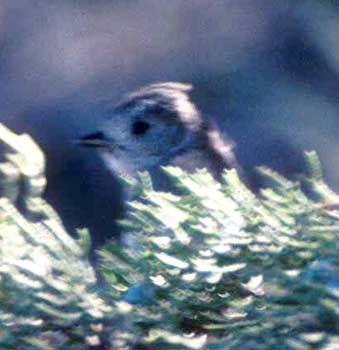
To my eye, the Oak Titmouse bill looks "thicker" but the mystery titmouse
bill looks a bit longer (however, my May 1982 photo of the MTY titmouse
is a bit foreshortened). By measurement, the Oak Titmouse bill (bill =
culmen) looks to be about 1.25X the width of the eye whereas the mystery
titmouse bill is about 1.75X the width of the eye.
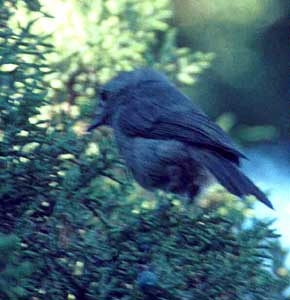 Paul
DeBenedictis (1997) in the June 1997 issue of Birding summarized
the work of Cicero (1996) on these titmice. It was Carla Cicero's monograph,
combined with earlier vocalization studies by Johnson (1987) and on genetics
by Gill & Slikas (1992), that led to the recent A.O.U. species split.
In DeBenedictis' paper are photo of both species -- it is very obvious
from those photos that Juniper Titmouse has a longer (and therefore thinner-appearing)
bill than Oak Titmouse. Harrap & Quinn (1995) give these ranges for
bill lengths (excluded the Baja race of Oak, B. i. cineraceus):
Oak 12.4-13.1 mm vs. Juniper 12.8-14.1 mm. Thus on bill length there is
only a little overlap (in the 128.8-13.1 mm zone). On bill differences,
the Lava Beds titmice seem to me to be closer to Juniper Titmice. [And
it is worth noting that the newest field guide rendition is misleading
on this point.]
Paul
DeBenedictis (1997) in the June 1997 issue of Birding summarized
the work of Cicero (1996) on these titmice. It was Carla Cicero's monograph,
combined with earlier vocalization studies by Johnson (1987) and on genetics
by Gill & Slikas (1992), that led to the recent A.O.U. species split.
In DeBenedictis' paper are photo of both species -- it is very obvious
from those photos that Juniper Titmouse has a longer (and therefore thinner-appearing)
bill than Oak Titmouse. Harrap & Quinn (1995) give these ranges for
bill lengths (excluded the Baja race of Oak, B. i. cineraceus):
Oak 12.4-13.1 mm vs. Juniper 12.8-14.1 mm. Thus on bill length there is
only a little overlap (in the 128.8-13.1 mm zone). On bill differences,
the Lava Beds titmice seem to me to be closer to Juniper Titmice. [And
it is worth noting that the newest field guide rendition is misleading
on this point.]
We also need to consider the potential races involved. Harrap & Quinn (1995) follow Phillips (1986) in naming only six races between what are now considered two species. The northernmost race of Oak Titmouse is P. i. sequestratus which ranges from the Rogue Valley of Oregon to Trinity Co., California, and occurs widely in western Siskiyou County. Compared to nominate inornatus (Mendocino to Santa Barbara counties; MTY birds shown here are this race), sequestratus is darker and "perhaps browner on upperparts (and flanks?)" to quote Harrap & Quinn (1995). Whatever the Lava Bed titmice are, they are certainly flat gray above and the flanks are gray (see my poor photo, above right; all Lava Bed photos taken 15 Aug 2000). The Juniper Titmouse contender is P. i. zaleptus of central-southern Oregon and western Nevada. It differs from the Juniper Titmice of southeastern California by being "overall paler and cleaner gray" (again quoting Harrap & Quinn).
In an email posting a year or so ago, John Sterling responded to questions raised by Al Eisner and others on the titmouse split:
The published study by Carla Cicero, "Sibling Species of Titmice in the Parus inornatus Complex" Univ. of California Publications, Zoology volume 128, is the source of the information that I will post (with a few side comments based on my experiences). Cicero revises the taxonomy of this group based on recommendations from her study. She proposes that there are four subspecies of Oak Titmouse Parus inornatus, one (inornatus) from the northcoast and Sierra Nevada foothills (ranging from southern Oregon and the western Modoc Plateau south to central Santa Barbara), another (affabilis) that intergrades with (inornatus) and is found from central Santa Barbara south to northern Baja California, a third (mohavensis) is restricted to the Little San Bernardino Mountains, and although appears grayer than coastal forms, it is clearly derived from these coastal forms, and finally the fourth (cineraceus) that is restricted to the Cape District of southern Baja California. The disjunct populations in southern Oregon and far northern California were formerly regarded as a distinct subspecies, "sequestratus" and these Oak Titmice have been found in juniper habitat--so beware! These populations appear to have a "tenuous" contact with Juniper Titmouse Parus ridgewayi zaleptus in the Modoc Plateau. I have not yet seen Oak Titmouse in western Modoc Plateau but they were described as being in very low density there.This commentary led to additional questions, and John Sterling qualified his remarks about the Modoc Plateau:
Cicero recognizes two subspecies of Juniper Titmouse with ranges split geographically along the eastern Nevada state boundary. The western subspecies zaleptus is found in California on the Modoc Plateau (I have seen very few there--they appear to be restricted to small "pockets" and in low densities), the foothills of the Warner Mountains south along the Great Basin side of the Sierra Nevada to Clark Mountain in eastern San Bernardino County. [Ed note -- the A.O.U. has since placed these titmice in Baeolophus instead of Parus and given Juniper Titmouse the name B. griseus because of priority problems.]
The populations that she did not study (or did not have clear results--I believe due to lack of specimens if I recall correctly) and therefore did not assign to a specific taxon are found along the Hwy 299 corridor in eastern Shasta County and into far southwestern corner of Modoc and northwestern corner of Lassen Counties.... These populations are found in the oak woodlands along with Nuttall's Woodpeckers, Wrentits and a few other typical "west-slope" species. They appear to me to be Oak Titmice by song, calls and habitat preferences. Someday, I would like to (or better yet, prefer that someone else) compare specimens from this population to compare them directly with specimens from other populations.
I knew that I'd have problems summarizing such a complicated issue in ten minutes and in such a short message! Reviewing most of Cicero's publication and not just her summaries have led me to alter and embellish on some of my previous postings. It seems that Lava Beds National Monument birds could potentially be of either species, Juniper or Oak Titmouse. The easternmost limit of Oak Titmouse is Mt. Dome, Siskiyou County ... which is just west-northwest of Lava Beds NM. These birds are found in juniper habitat so it is possible or even likely that they also occur in Lava Beds NM. These birds from Mt. Dome also are new distributional records that were not in Grinnell and Miller as were some additional specimens of Juniper Titmouse from the western Modoc Plateau near Clear Lake. One problem is that Cicero did not analyze specimens from Lava Beds NM itself, which is the region directly between Mt. Dome and the Clear Lake area. So...I guess that people need to identify these birds by vocalization, bill size (much larger in Juniper Titmouse), and plumage and not simply by range or habitat! I have always thought that the Modoc Plateau was defined as the region east of Tule Lake and Lava Beds NM, west of the Warner Mountains and directly north of the line from Canby to Alturas. This seems to be different from Cicero's definition and so may be creating some confusion when I reported from her summary in my previous post.This is all interesting but leaves us where we started -- not knowing which birds are in Lava Beds. DeBenedictis (1997) says that "Pacific-slope [titmice] and interior types apparently make contact in Modoc County in northeastern California. Unfortunately, these sympatric populations were not well characterized; Dr. Cicero is still studying them, and we can expect to see more details about them in the future. One such population is especially interesting, in that it seems to combine Pacific-slope morphology and genetics with an interior ecology."
After putting this page together, I wrote Dr. Cicero for her comments. This is her response (1 Sep 2000):
I have spent the past several years gathering specimens/data on titmice in the Lava Beds NM region, and hope to write up the results this winter. The basic situation is this: the 2 species of titmice occur in narrow secondary contact between Lava Bads NM and the Tule Lake Hwy. Within this zone, there is a very sharp change in mitochondrial DNA type from diagnostic Oak Titmouse to diagnostic Juniper Titmouse. Thus, both kinds may occur in Lava Beds. Because the birds vary clinally in size and color across thisAs P. William Smith commented to my initial post, sometimes nature does not fit into neat little boxes. It can be dynamic and ambiguous. He said this from the perspective of living within the range of the "Olympic Gull" (i.e., the intergrade zone of Western & Glaucous-winged Gulls). It now appears that the mystery titmice (titmouses?) discussed here are best identified as the "Lava Beds Titmouse." And leave it at that.
zone, they are not easily assigned to one species or the other in that region based on external characters. Vocal variation appears to be complex in this area, and it's too early to say whether voice can be used to
diagnose the 2 species in/near the zone of secondary contact. Ned [Johnson] and I are continuing to record titmice from throughout their ranges for a study of vocal variation, including across the contact zone.Although the "mystery" of identifying the 2 species of titmice in Lava Beds remains a problem, that is the reality of the situation.
Many thanks to Carla Cicero, Bruce Deuel, Helen Green, Steve Hampton, John Mariani, P. William Smith and John Sterling for comments on this little-known but quite interesting problem, and to John Sorensen for allowing me to post some of his photos. These images are shown here at very low resolution and do not adequately capture the quality of the originals.
Literature cited:
DeBenedictis, P. A. 1997. Complex titmice. Birding 29: 238-241.TOP
Gill, F. B., and B. Slikas. 1992. Patterns of mitochondrial DNA divergence in North American crested titmice. Condor 94: 20-28.
Harrap, S., and D. Quinn. 1995. Chickadees, Tits, Nuthatches & Treecreepers. Princeton Univ. Press, Princeton, N.J.
Johnson, L. S. 1987. Pattern of song type use for territorial defence in the Plain Titmouse Parus inornatus. Ornis Scand. 18: 24-32.
Phillips, A. R. 1986. The Known Birds of North and Middle America. Part 1: Hirundinidae to Mimidae; Certhidae. Denver Mus. Nat. Hist., Denver, CO.
Page created 28 Aug-1 Sep 2000